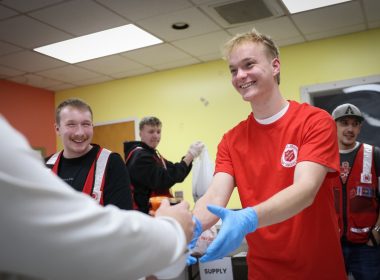A partnership with the National Health Foundation is giving some of Ventura’s most vulnerable a place to stabilize after the hospital.
“Today is a good day.”
It’s just one of the rosy sentiments printed across a piece of framed wall art adorning each one of the six rooms. Each has its own unique pick-me-up, along with two beds and nightstands, and a TV.
But the simplicity of the arrangement belies a facility positioning itself to tackle a complex issue. The dozen beds are part of the National Health Foundation’s (NHF) new Pathway Recuperative Care center, which recently opened at The Salvation Army’s downtown Ventura, California, location. The Salvation Army is leasing part of its facility to NHF, which had sought to move to Ventura for several years, but until now, hadn’t found the right location.
The initiative fills a critical need, providing shelter for individuals facing homelessness who’ve recently been discharged from a local hospital. Without such intervention, hospitals are often forced to keep patients in their beds for extended periods of time, simply because they have nowhere else to release them. And because the patients’ conditions often require care beyond the date of their discharge, many shelters are ill-equipped to meet their needs, and the individuals often end up back in the hospital.
Five local hospital systems—both public and private—will foot the program’s roughly $700,000 annual bill, which could turn out much cheaper for them than the alternative. According to Bonnie Rouda-Ruiz, the facility’s Medical Coordinating Nurse, the NHF’s two Los Angeles County Recuperative Care facilities have together saved hospitals and the health care system an estimated $34 million.
“The population of displaced homeless people is getting bigger and bigger in Ventura County every year,” Rouda-Ruiz said “You have to look at the daily costs of a hospital stay, anywhere from $2,500–3,500, and then compare that to what it would cost for them to stay here.”
Any one of the five hospital systems can discharge a patient to the center, which is staffed with a nurse, a caseworker, and a maintenance worker. The program offers three meals a day, limited medical care and transportation to follow-up appointments. The length of a patient’s stay will be determined on a case-by-case basis by the hospitals, but no client stays fewer than seven days. The goal will be to find them stable housing, an area in which The Salvation Army is well-seasoned.
“When their time is up at recuperative care, our shelter manager gets in contact with their social worker to see if we might be able to transition them into [The Salvation Army’s] shelter, or if we can help them with financial assistance, and potentially find them a place and pay the first month’s rent,” said Sandra Troxell, The Salvation Army’s Program Director. “The collaboration has been effective. And it’s in our interest too that people don’t leave out of our facility back to the street.”
Despite the center’s modest size, officials such as Oxnard City Housing Director Arturo Casillas, are bullish on its potential. “You can do a lot with 12 beds, compared to what we’ve had before,” he said.
Troxell said the facility may add more beds down the road, but for now they’re focused simply on doing what they can with what they have.
“At the end of the day, some of the clients that come here are familiar with our case managers, especially in the outreach program, so we have worked with them at some point in time,” she said. “When they leave recuperative care, they might cross our paths again, as well. So it’s in all of our interests to do the best on our side to provide the client with the resources they need to be brought out of the system.”










